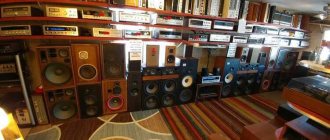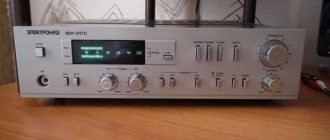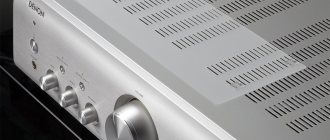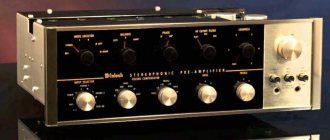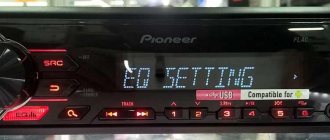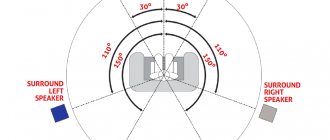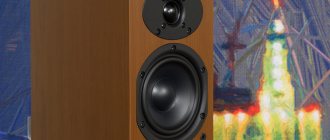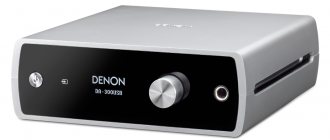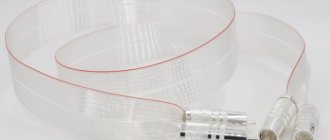Modern flagship amplifiers from Denon: PMA-SX1, S1 and others
Therefore, for the PMA-SX1 we tried to select and purchase the best parts. The PMA-SX circuit configuration pursues purity, making the circuit even simpler than before and inheriting the conventional model. As a result, the PMA-SX balancing control, REC out selector, phono EQ ON/OFF switch, and balancing input ON/OFF switch are eliminated. The tone control and headphone output were not installed in the amp for a better final sound. As a result of careful circuit implementation, balance control and tone control are also eliminated
Internal wiring is kept to a minimum and oxygen-free OFC copper is used for wiring. Signal transmission losses are eliminated. The design of buttons and knobs and other parts, as well as the chassis design, are also simple, and the concept of a “simple and high-performance” amplifier in the PMA-SX1 has been carefully implemented.
Denon became the first device in 24 years to have the best CR-type phono preamplifier.
The regular PMA-SX only supports MM phono input, but the PMA-SX1 supports both MC and MM inputs. A CR type phono stage circuit, equipped with an amplifier with two FET differential input circuits connected in parallel, is mounted on a phono equalizer, which has a dedicated input terminal for each MC/MM. As a result, linear reproduction can be achieved without differences in timbre between low and high frequencies, which is a problem with conventional NF type. Moreover, high quality parts, carefully selected, are used in the CR circuit. The equalizer circuit is only powered when the phono input is selected. When playing a CD, etc. The phono stage is powered off and the device is designed to minimize the impact on other circuits.
It can be said that the CR type phono equalizer is one of the main features of this device.
According to Yoneda, this CR-type phono stage (the Japanese call it a phono equalizer) has become one of the main topics of our time. In previous S series, the phono input was MM only, and the phono EQ was only NF type. Mr. Arai explains the reason why CR was installed: “The phono equalizer has NF type and CF type. The normal NF type has an RIAA element in the NFB (negative feedback) loop to equalize the frequency response so that low frequencies are large and high frequencies are small. The problem with this type of circuit is that the solid-state amplifier accepts feedback to some extent, so it can be overdriven in the low range and be in a state where the amount of feedback is insufficient in the high range. “(Mr. Arai).
On the other hand, the CR type is larger in scale than the NF type, and it is difficult to ensure the signal-to-noise ratio, but the energy balance is more uniform and the sound quality is significantly better compared with NF.
CR board in SX1
The CR type is a complex format in terms of providing S/N etc. compared to the NF type, but is superior in sound quality.
“The CR type phono equalizer makes it the point where the frequency response element is located. For example, a type in which a CR element is suspended at the input terminal and amplified in the last stage, the CR for each input and output in the PMA-SX1 CR element is inserted into the middle of the two amplifiers. The CR element has high impedance, so it must then be received by an amplifier. ", he said.
The CR type phono equalizer was the first to be used in Denon products in 24 years. Although the CR type phono equalizer found in the PRA-2000 preamplifier has been recognized by some critics in the past, the NF type has been accepted as more common and is installed, for example, in the PRA-2000 ZR.
The CR type is aurally superior in terms of clarity and sense of energy across the full bandwidth.
Mr.
Arai recounted the episode that led to the use of the CR type phono preamplifier. Arai still used the PRA-2000ZR (NF-RIAA) phono stage when playing analog recordings. The reason was the sound quality, but in order to analyze the sound quality of the PRA-2000ZR phonon sound when designing this amplifier, I compared different phonon sounds. As a result, it was found that the CR type had a direct and natural nuance that was not present in the NF type, and that it was proposed to be installed in the PMA-SX1. In addition, in the CR type, it is difficult to ensure S/N, because the amplifier has two stages, but with high modulation distortion, etc., that there is no audible auditory perception, which hardly appears in the measured values, also a sense of energy appears in each strip. This is what led to the decision in favor of CR.
Mr. Arai who talks about the attractiveness of CR type
In addition, since the performance of CR looks better than NF type due to the circuit configuration of CR type, we used selected parts. Regarding capacitors, in general, we use large size polypropylene film capacitors for audio in this machine. Resistors were also used for audio when assembling the CR board.
The MC input terminal is equipped with impedance switching.
The MC input terminal is also equipped with a high/low input impedance switch. In addition to medium and high impedance cartridge, low impedance cartridge from 2 to 10 ohms, represented by foreign high-end brand cartridges, is also supported with optimal input impedance.
The PMA-SX1 is installed in the listening room where the sound of DENON products is determined
Mr. Yoneda also mentions the cartridge when using the MC input on the PMA-SX1. The Denon MC-type cartridge DL-103 is still a relevant product 50 years after its introduction.
Cartridge, used at the presentation when listening to PMA-SX1
This model (103) is virtually unparalleled in audio equipment, and is still used by many analog fans today. The "high" position is expressed in the enthusiasm that is dedicated to the DL-103. Yes, today there is an analogue boom, but Denon's mission is to prepare the environment to enjoy analogue while analog audio sources still exist.
Inverted balance is the art of Denon
Although the PMA-SX1 uses a balanced circuit, it naturally also handles an unbalanced phono input. This amplifier has a balanced design in which both balanced and unbalanced input signals are directly fed into the balanced voltage amplification stage without the use of a conversion circuit. By performing balancing using an inverted balance circuit, low distortion frequency and high signal-to-noise ratio are realized, and the shortest signal path is realized, although it is a balance amplifier. Mr. Yoneda described this inverted balance scheme adopted in the "POA-3000 RG" as "a technology that can be called the art of Denon."
Inverted balance circuit supplies the input signal to the amplifier with a balanced configuration in high quality
■ Includes a switch to reverse the polarity of the balance input
In addition, a polarity switch has been added for the balanced input. Even if there is a 3rd HOT, which is mainly for domestic goods, and a 2nd HOT, which is often for imported goods, this can be done by simply toggling the switch on the rear panel. In this regard, Mr. Yoneda "It is a pain and a shame in terms of avoiding conversion as much as possible, but given the current situation where manufacturers using 3rd HOT in domestic models, polarity switching has been installed."
As far as I understand, the Japanese XLR connector has an inverted polarity, which does not correspond to that accepted in the rest of the world, so Denon for Western consumers made a switch that changes the polarity in the XLR connector. I wonder what this is like in amplifiers from other Japanese companies, such as Yamaha, Onkyo or Sansui?
Polarity switch added to balance input
In addition, Denon PMA-SX1 is equipped with an “EXT. PRE" with fixed gain, which is convenient for combined use with a home theater system, including sharing the center speaker. It can be used by connecting it to a pre-output, such as an AV amplifier. In addition, one REC I/O system is installed.
Power unit
The PMA-SX1 has a very large power transformer considering its power output (only 50 watts per channel). The output stage and voltage amplification stage adopt high-quality custom sound of custom block capacitor using low-gain foil, which has been tested repeatedly by trial production. It is used as an independent power source from a dedicated winding of the transformer and provides a powerful power supply circuit capable of sufficiently supplying the clean current required by the amplifier circuit.
The power supply is the most important point in PMA-SX1
The aluminum sand casting housing is filled with a special resin to eliminate vibration generated by the power transformer.
The power transformer is filled with a special resin after sand casting aluminum, similar to PMA-SX, to eliminate the vibration generated by the power transformer. In addition, careful magnetic shielding suppresses noise in the event of magnetic flux leakage and ensures clean power supply. Transformers with very thick windings are said to produce clear and powerful sound. The weight increases significantly from the use of this power transformer.
The "direct mechanical ground" concept used by Denon hi-fi components has also been revised. Mr. Yoneda's design philosophy is that “the idea is to keep the circuit in a strong case, because the sound quality is affected not only by the electrical circuit, but also by the mechanical part, and it is very large. Electrically speaking, this means trying to probe the low impedance point, and when this was looked at, it turned out to be a very dirty place in the sound.
"Direct mechanical grounding", which completely eliminates unnecessary vibration, has been reapplied.
In particular, the power supply is placed on a chassis with a hybrid layer structure with a lower center of gravity. An internal vibration source is located near the foot to reduce vibration on the ground. The transformer, large-block electrolytic capacitor and rectifier diode are floating treated using various materials to prevent vibration from spreading to the amplifier circuit and protect the power supply circuit from vibration originating from outside.
Anti-vibration measures such as cast iron feet adopted in PMA-SX
In addition, the legs in the amplifier are made of cast iron. Vibration control and vibration suppression are carefully implemented in parts such as the top panel, where the resonant frequency is distributed, by precisely adjusting the size of the air hole.
Top panel with precisely adjusted hole sizes and diffuse resonance frequency
We used a design that is simple to the extreme
The PMA-SX1 is characterized by its simplified design to the extreme. Only a large volume knob surrounded by a backlight and an input switch knob are located on the front panel. “I wanted to express the Denon sound in the design,” said Yoneda.
Naturally, the DCD-SX1 (right), which is paired with the PMA-SX1, has a sense of unity in both design and sound.
“With the goal of making amplifier design easier, designers began to embrace simplicity. And if we had to make it so simple, the volume controls have also grown in size. Largest Denon volume control ever. The next time I wanted an accent I added an amber backlight, but this time I was interested in the reflection on the front panel of the PMA-SX. I used a different volume element using a 3.7mm thick front panel extended, but this would have lost its simplicity, so the panel could be a whopping 15mm thick. It costs money, but it's not only good for design, but also for sound quality, such as stabilizing the electrical circuit and improving damping characteristics. I could influence this, Yoneda said. This large volume knob uses motorized volume control using a multi-pin wire brush. This is an analog type part that Denon has consistently focused on, and since it does not require an input buffer circuit, it has the advantage of being able to make circuit configuration simpler than a digital regulator. Also included in the design is a solid aluminum faceplate that is up to 15mm thick, which Yoneda emphasized has the effect of eliminating a mixture of external vibration and external noise. In addition, the element causing deterioration in sound quality is eliminated by using a cylindrical aluminum cutout cover and a cutout handle made of aluminum hard material.
Large volume knob with amber backlight
The amber lighting around the volume control can be adjusted to three levels: bright, dark and off.
The speaker terminal also uses a large size, which can also fit a Y-adapter and a very thick cable. Due to the horizontal row arrangement, the connection can be made more conveniently and the L/R cables will not be able to touch each other.
Speaker terminal switches from vertical layout to horizontal L/R layout
Denon's high-quality amplifiers are designed to be remote-control-free, as they eliminate elements that affect sound quality. However, the PMA-SX1 was designed to be compatible with remote control, in response to changing user requests as time changes. On the other hand, to avoid affecting the sound quality, the microcomputer stop mode, which stops the power supply to the microcomputer, is set when the amplifier is not running. You can also use this remote control to control your Denon CD player.
For the first time in high-end DENON models, remote control is used.
The microcomputer stop mode was originally an accident during the design at Denon, and they liked the idea. According to Arai, the microcontroller clock speeds are a maximum of 4 to 8 MHz, but it was determined to be the same as the noise source and never exceeded it. It starts when it receives a pulse during operation, and the microcomputer stops 2 seconds after the operation is completed. As a result, standby power consumption was also reduced by 0.2 W.
Difference between SX and SX1 The PMA-SX1 was designed with sound quality in mind compared to the PMA-SX, and there is no compromise in sound quality, Yoneda claims about the PMA-SX1. In fact, in terms of weight alone, the SX1 is slightly heavier at 30.4kg compared to the PMA-SX's 30.2kg. So what are the factors that have reduced costs? Of course, there is a pricing strategy by Denon to match the price range with the paired "DCD-SX1" SACD player. Additionally, consistent with DCD-SX1, PMA-SX uses very high quality natural maple wood for the side panels.
At the end of the presentation, Mr. Yoneda stated, “The PMA-SX1 is the model that best showcases the UHC-MOS technology that is at the heart of Denon amplifiers.
Finally, the main characteristics of the PMA-SX1.
Rated output power 50W + 50W (8 ohms, 20Hz-20kHz, THD 0.1%)
The maximum power is 100W + 100W (4 ohms, 1 kHz, THD 0.7%)
Total harmonic distortion frequency is 0.017% (-3 dB) into 8 ohms, 1 kHz
Speaker impedance from 4 to 16 Ohms.
Preamplifier input sensitivity/impedance is 2.5 mV/47 kΩ for PHONO MM, 200 μV/100 Ω (high) and 50 Ω (low) for PHONO MC, 105 mV/95 kΩ for balanced, 105 mV/47 kΩ for single-ended entrance. S/N is 82dB for PHONO MM (5mV input signal with input terminal shorted)
70dB for MC PHONO (0.5mV input shorted to input terminal)
Unbalanced input 105 dB.
Power consumption 275 W
External dimensions – 434×181×504 mm
Weight - 30.4 kg.
In conclusion, I want to say that Denon has invested all its developments over many years into this flagship device, and for power lovers - please note - the flagship power is 50 watts per channel, while the current can reach 240 amperes, which of course will probably swing any load.
Denon PMA-SA1; DCD-SA1 HIGH END. Magazine "Stereo & Video"
Excellent accuracy, amazing detail, but sometimes it seems that the contours of the instruments become slightly sharper, even at mid frequencies.
Save and read later -
Already at first glance, there is no doubt that this is a “creation of human hands”, and not a mass production assembly line. The dimensions and weight of the amplifier somehow do not quite correspond to its rather modest power. The output power is only 50 W per channel into an 8 ohm load, and the Denon PMA-SA1 weighs as much as 30 kg.
The weight of the player matches the amplifier. As soon as we unpacked it, we immediately felt that there should be a lot of good equipment, and more than 20 kg confirmed this. The Denon DCD-SA1's design places great emphasis on electrostatic shielding, and its panels are a pie. There are also copper sheets attached to them from the inside, namely sheets, not foil. Transport is also covered with the same copper plates. Separate panels with vibration-isolating gaskets, a special design, Denon SVH (Suppress Vibration Hybrid) vehicle suspension, installation of transformers in heavy casings with subsequent filling with compound, and more help to improve anti-vibration protection. The installation of transformers should be discussed separately. To reduce mechanical vibrations, they are filled with epoxy compound. But the filling is carried out in a specially made casing, which is cast from cast iron. And in the amplifier, the rectifier capacitors are installed in similar cast-iron casings. It is clear that the mass of cast iron noticeably “gives weight” to the models.
The player has two identically sized transformers, one for powering the digital part, the other for the analogue part. The amplifier has one transformer, and both channels are powered not only from the same windings, but also through one rectifier and filter. Almost always, the power of the power supply is taken less than necessary to provide the declared power. Indeed, in most cases, the amplifier operates at maximum modes only with short pulses, and the average power value is several times less. This short-term power is provided by the rectifier filter capacitors, so experts usually show increased interest in their capacitance.
But if the signal is longer, and this happens, for example, quite often in organ music, then the supply voltage “goes down”, and with it the output power. In technical terms, the linearity of the amplitude characteristic is violated here. But it is precisely the main source of nonlinear and intermodulation distortions. But let’s immediately make a reservation that it is extremely difficult to measure distortions of this kind, because this nonlinearity is nonstationary, that is, it changes over time. However, distortion measurements are carried out in steady state conditions. It is precisely from such situations that an increase in the power of the power supply, or more precisely, the transformer, protects. And in our opinion, this is especially important for amplifiers of relatively low power, where there is a higher probability of operating at the limit.
The output stage of the amplifier is built on field-effect transistors. Field devices have taken root well here, having some advantages over bipolar transistors. Denon PMA-SA1 has protection against short circuit in the load, against the appearance of constant voltage at the output, and thermal protection. The protection system is probably made in two stages, where the first, fast-acting stage is based on electronic shutdown, and the second stage is based on relays, which usually perform a switch-on delay or forced shutdown (muting). When the protection is triggered, the network indicator changes color from orange to red.
For vinyl fans, the amplifier has a built-in corrector for a turntable with a MM head. But, apparently, so much attention is paid here to the issue of minimizing interference that this part of the circuit has its own separate power switch located on the front panel. And when the corrector is not in use, it is recommended to turn it off.
There are no tones, but there is a stereo balance control. All this gives rise to some thoughts. The balance control is needed to compensate for either the difference in transmission coefficients in the amplifier channels, or the difference in the sensitivity of the speakers, or the asymmetry in the installation of the speakers if they are installed at different distances. But all of them should be excluded when it comes to High End. Otherwise, what kind of equipment is this that cannot do simple things like selecting the gain in the channels? And the exclusion of timbres, we have talked about this more than once and will always talk about it, leads to the fact that correct playback is possible only in one single case, when the volume you set is exactly equal to the volume when recording (and is it always possible in an apartment to set the volume equal to volume in a concert hall). In any other case, there will be subjective timbre distortions due to the fact that the human ear has different spectral sensitivity at different volumes. Remember the curves of equal volume; it is clearly visible from them that as the volume level decreases, the sensitivity of the ear to low and high frequencies weakens and in order to adequately perceive them, their level must be increased. By the way, although these are generally accepted characteristics, they are average characteristics. Anyone may have differences from them, some more, some less. And there is nothing to compensate for this lack of timbre in the High End. The arguments of some audiophiles that the presence of timbres distort the phase response are, of course, correct, although this is not easy to grasp. And changes in ear sensitivity when changing volume are felt by almost everyone, and without much strain. Therefore, whether it is worth giving up timbre (and leaving balance) is an open question.
Remote control has already become so integrated into our AV life that it becomes uncomfortable without it. It’s already somehow unusual that in order to adjust the volume you have to get up and go to the amplifier. But it’s not always possible to determine exactly right away. Of course, the lack of a remote control is a noticeable disadvantage of equipment of this class. Although you understand that for remote control you need to build in a receiver that works with a digital signal, which means it can give interference. Other options for changing the volume use electronic principles, for example, multiplying DACs, and the presence of electronic keys here does not allow obtaining the required highest quality. Although some High End manufacturers are not afraid of remote control, Denon in this case offers a different solution and the Denon PMA-SA1 is not covered by remote control.
The amplifier has a pair of line output connectors for recording. The recording selector selects one of the modes. In the source position, the selection is made by the input selector, and the signal is sent to both outputs. The other two positions strictly bind one of the outputs to a specific input, allowing dubbing from one device to another (or vice versa). All switching of sources, both the input selector and the recording selector, is carried out using a relay. For better symmetrical connections, differential inputs are available. But only one pair, which we immediately connected to the same output of the player.
To convert digital to analog, the Denon DCD-SA1 is equipped with a PCM1792 DAC manufactured by Burr Brown (now part of Texas Instruments). This is a rather complex microcircuit; during conversion, it uses intermediate stages for which the digital signal is divided into two streams (6 high-order bits and 18 low-order ones), which are processed independently. The chip has a built-in oversampling circuit, digital filters and generates a differential signal for a balanced output. The player has a mode in which this DAC is used to convert external PCM signals with a sampling frequency from 32 to 192 kHz. They are fed to the optical or coaxial input and removed from the output in analog form. In addition to the DAC's built-in filters, there is proprietary Advanced AL24 processing. It works with digital signals up to 192 kHz and performs upsampling and adaptive filtering of the signal, which, according to the company, results in increased dynamic range, improved accuracy and purity of spatial information. By the way, the DAC has taken measures to reduce jigger. Also, a set of measures to suppress jitter and impulse noise is provided in the Denon DCD-SA1 generator.
Communication with the player is not difficult. Everything, including the remote control, is quite simple and clear. The most difficult operation, creating a playback program, is performed traditionally: the number of the desired track is entered using the numeric buttons, it is stored in memory, after which it is prompted to enter the next position. It is quite natural that devices of this class do not rely on the reproduction of compressed formats, and the Denon DCD-SA1 is no exception. He doesn’t understand MP3 or WMA.
The performance of the set will appeal to connoisseurs of “dry” sound; here you can feel the unobtrusive impartiality so valued by some. Excellent accuracy, amazing detail, but sometimes it seems that the contours of the instruments become slightly sharper, even at mid frequencies. A slightly noticeable chill is also present at low frequencies, and although the amplifier is quite accurately controlled with a powerful, sharp bass, it is advisable to pair it with speakers with good sensitivity, since its power is only sufficient for chamber sound.
Prepared from Stereo & Video magazine, June 2006.
This review has been read 22,481 times.
Amplifier Denon PRA-S10/POA 3200
This luxurious Japanese amplifier can without any stretch be classified as a “super heavy Hi-Fi”, both taking into account its cost and weight and size characteristics. Since people are always greeted by their clothes, it was this amplifier that made the strongest impression on the experts (very positive!). Indeed (healthy and heavy!) metal boxes with a thick front panel, with huge turned metal control knobs and, moreover, an elite champagne color. This color is very popular today and indicates the special claims of the manufacturer (or perhaps the buyer?) of elite audio equipment. But Denon made it really well! Just like a couple of NAD amplifiers, the preamplifier has a balanced input and even a balanced output(!), while the power amplifier has only standard unbalanced RCA connectors. But don't worry, if you buy this kit you will always have the option in the future modernize your complex by replacing the standard terminal with an amplifier with a balanced input. Denon, by the way, has recently significantly increased the number of “top” Hi-Fi models, so you will always find something to choose from. Moreover, all audio equipment from Denon is famous for its excellent workmanship and has excellent technical characteristics. The build quality of both the preamp and power amplifier is impeccable. The audio input and output connectors are of high quality and gold-plated, the inscriptions and graphics are applied neatly and are easy to read from any distance. The neat installation of the amplifier's printed circuit boards is visible through the wide ventilation slots. Both the front and the power stand stably on widely spaced cylindrical “legs” - supports of large diameter. In a word - Denon is Denon.
Controlling the amplifier is very comfortable. Large-diameter control knobs fit well in the hand, have “zero play” and an extremely smooth movement. With the remote control, fans of a sedentary lifestyle will be able to comfortably control almost all functions of the amplifier from their favorite chair. In addition, this remote control will be able to control other Hi-Fi components of your system, if they are indicated by the indication of the current input of the program source selector in the pre-amplifier, in a ring around the selector there are red rectangular LEDs that glow beautifully for the selected source. Very clear and convenient! As for the quality of connectors and connectors, it is simply top-class! But, of course, you won’t connect banana plugs to the new “safe” speaker connectors even if you wanted to – and don’t try! “Bananas” - No passaran!
The Denons sound clean and neat. The stereo effect and surround sound are impeccable. However, their sound, for all its “correctness,” clearly lacks “spark”; although they sound quite natural, they are somewhat detached. The music they perform flows smoothly and without any audible defects, but it doesn’t captivate! In Direct mode, the amplifier's sound clearly lacks low frequencies, although they are there and of quite decent quality. Let us repeat once again: although almost all components of the amplifier’s sound quality do not cause any complaints in themselves, in total they give, although quite decent, but by no means outstanding sound. But Denon earned a “solid four plus” for sound honestly and deservedly. Based on the totality of its advantages, it is a very good model! This is the most beautiful amplifier in the test! So in the category “for the most beautiful and effective design” - first place!
